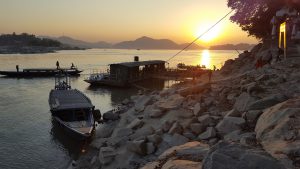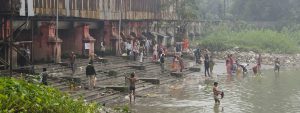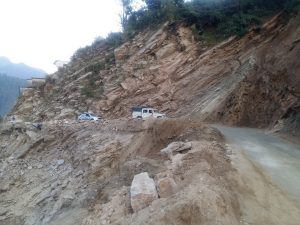Mohammad Shafi Sofi has never seen the level of water in the Jhelum river as low as it has been in the last few weeks in his 34 years of service. “The situation is pretty bad. We faced drought conditions last year as well, but not as bad as we are witnessing now,” he told thethirdpole.net. Sofi heads one of the major water supply divisions (Sopore) in north Kashmir.
“At many places near our water supply schemes, the Jhelum’s riverbed is exposed. We had to press machines into service to make diversion channels towards our off-take points,” he said.
According to him 45% capacity of the 14 water supply schemes in his division have been affected by receding water levels. The situation is even worse in the adjoining Baramullah division where over 70% of 18 water supply schemes have been affected.
“The receding water level in Jhelum has put us on our toes. We take turns to supply water to various areas. And in most of the areas we are supplying water through tankers with our water supply schemes badly impacted by the drawdown,” said Zaffar Ahmad Faktoo, the Executive Engineer of Baramullah division. He said he caters to the needs of 225,000 people.
Ravi Kanth Sharma, who heads the Awantipora Public Health Engineering (PHE) department in south Kashmir, said that the Pampore Water Supply scheme of his department, which has a capacity of 750,000 gallons, was almost crippled for four days until the water was diverted towards the sump. “We use water tanker service for those who have been badly affected,” Sharma said.
‘Fighting a tough battle’
Elsewhere also, officials of the PHE department, which is in charge of providing drinking water to people across Kashmir, have been fighting a tough battle. There has been no rainfall in October so far and just 14mm rainfall in September against a normal 32 mm for both months. Over 50 small and large water supply schemes are currently suffering under the lowest ever flows in the region’s main river, the Jhelum.
On October 18, Kashmir’s Irrigation and Flood Control (IFC) department, which monitors water levels in River Jhelum, posted on its facebook page that gauge reading of -0.65 feet was the lowest gauge ever recorded at the Sangam site, a benchmark recording station for Jhelum’s water levels in south Kashmir near the river’s source at Verinag.
Sonum Lotus, director of the Jammu & Kashmir Meteorological department said that the monsoon circulation remained very little this year particularly during the early monsoon, due to which the region received such low rainfall.
Data regarding rainfall over past 17 years for the months of September and October, shared by the Meteorological Department with thethirdpole.net shows that the previous year and the current year have stayed extremely dry in contrast with past several years.
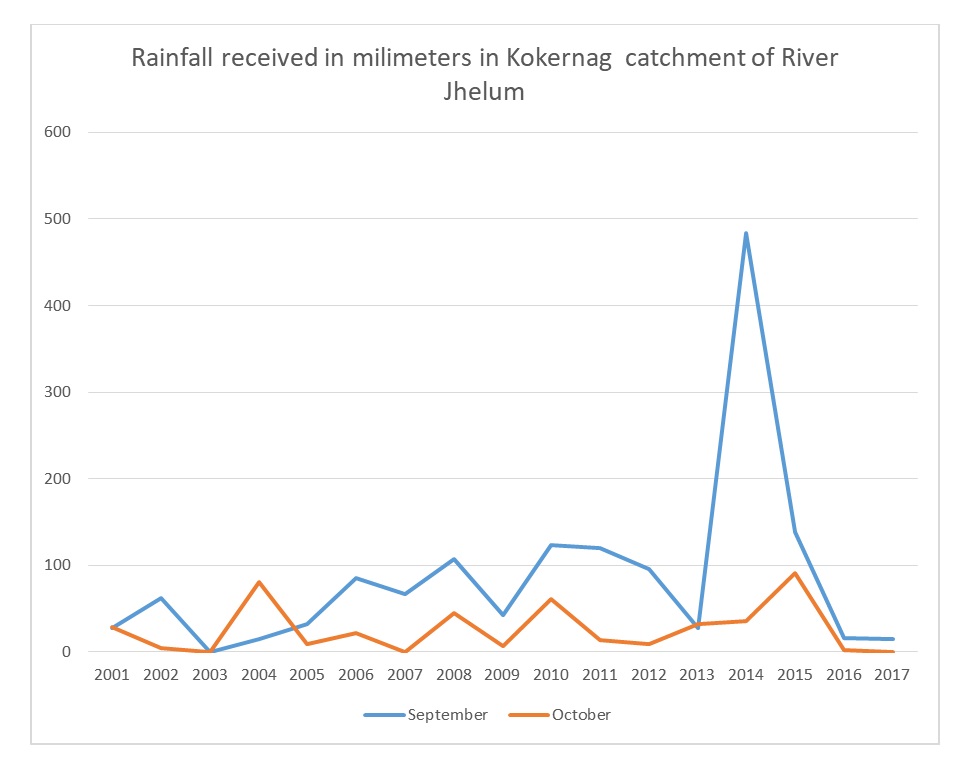

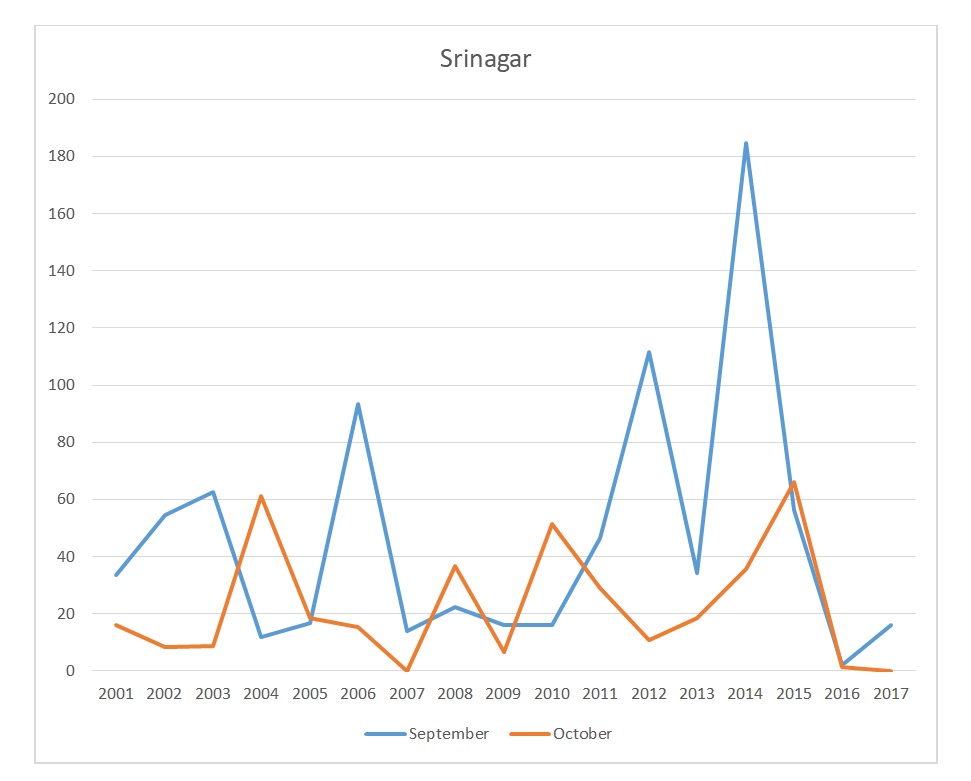
Climate change and glaciers
Shakil Romshoo, who heads the Earth Sciences department at Kashmir University and has worked extensively on Kashmir’s glaciers, says that the low discharge in the Jhelum during October is not abnormal as it is the lean period now.
“However, if, you look at the time series of the observed discharge for the Jhelum since the 1960s, there is significant decline in the discharge of the Jhelum since 1990s and this is attributed to the loss of glacier mass in the Kashmir basin,” Romshoo told thethirdpole.net.
“Keeping in view the changing climate in the region, we expect that the trend would continue in the future,” he said.
According to Romshoo, the depleting stream flows in the upper Indus basin (Jhelum), particularly during spring and summer seasons would significantly impact various dependent sectors particularly agriculture downstream, but the low stream flows in autumn or winter are not a cause of concern because of the low crop water requirement during the autumn and winter seasons downstream.
Regarding the impact of low water flow in Pakistan, Romshoo said: “The low flows during the autumn are not unusual. As the winter sets in, there will be snowfall in the upper Indus basin (including Jhelum basin) and the stream-flow will become normal during spring and that is when you need the waters for irrigation.”
He added, “As far as the hydropower generation is concerned, it always suffers due to the lean (low) flows during autumn and winter. Dams like Mangla and Tarbela in Pakistan store waters during spring and summer so that they could run and generate power (although at a significantly reduced generation capacity) during autumn and winters as well.”
Dying fish stranded on Jhelum’s banks
Over the last day reports have come of dying fish being stranded on the banks of the Jhelum, sparking panic among locals. The deputy divisional commissioner of Kashmir, Syed Abid Rasheed Shah has circulated a message asking the public not to panic, in his message he wrote, “We have taken water samples as well as samples of fish. Most of the fish washed up ashore are not dead suggesting that the oxygen content of the river water is low.”
As the news and WhatsApp videos of fish washing up to the banks spread, the authorities have asked that test results be done on an urgent basis and be distributed. While the authorities are speculating that the reason could be due to the unusually dry weather, they are waiting on the research results before making public remarks.
With additional reporting from Riyaz Wani. Both Athar Parvaiz and Riyaz Wani are freelance journalists based in Srinagar.
We want to hear from you! Tell us what you think about The Third Pole and you could win $100. Take our survey here.
![<p>Water levels in Jhelum have receded to abysmal levels [image by: Athar Parvaiz]</p>](https://dialogue.earth/content/uploads/2017/10/Water-levels-in-Jhelum-has-receded-to-abysmal-levels-Athar-Parvaiz.jpg)



